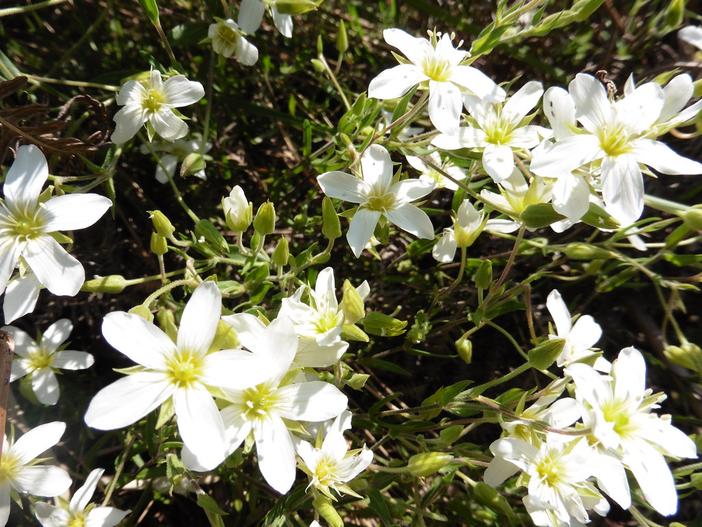Mountain Sandwort
(Arenaria montana)
Mountain Sandwort (Arenaria montana)
/
/

Thibault Lefort
PDM 1.0
Image By:
Thibault Lefort
Recorded By:
Copyright:
PDM 1.0
Copyright Notice:
Photo by: Thibault Lefort | License Type: PDM 1.0 | License URL: https://creativecommons.org/publicdomain/mark/1.0/ | Uploader: Thibault Lefort | Publisher: Flickr


























Estimated Native Range
Summary
Arenaria montana, commonly known as Mountain Sandwort, is an evergreen perennial herb native to the mountainous regions of southwestern Europe, including the Iberian Peninsula and the Pyrenees. It thrives in alpine meadows, rocky slopes, and limestone scree, where it forms dense mats. This plant typically grows 14–22 cm (6–9 in) tall and features lanceolate or ovate green to grayish-green opposite leaves, each 10–30 mm (0.4–1.2 in) in length. From mid to late spring, Mountain Sandwort produces a profusion of white to near-white flowers, about 25 mm (1 in) in diameter, arranged in cymes of 2 to 10 flowers each. The flowers are highly ornamental, making it a popular choice for rock gardens and alpine plantings.
Mountain Sandwort is valued for its mat-forming habit and showy flowers, which can create a carpet of white in the garden. It is often used as ground cover, in rockeries, and in border fronts. The plant requires well-drained, sandy to sandy loam soils with moderate acidity (pH 5.5 to 7.5) and is somewhat drought-sensitive due to its shallow root system. It has earned the Royal Horticultural Society’s Award of Garden Merit, indicating its exceptional performance in gardens. For best results, Mountain Sandwort should be grown in full sun to part shade and provided with low to medium amounts of water. While generally low-maintenance, it can suffer from root rot in poorly drained soils and may require protection from excessive winter wetness.CC BY-SA 4.0
Mountain Sandwort is valued for its mat-forming habit and showy flowers, which can create a carpet of white in the garden. It is often used as ground cover, in rockeries, and in border fronts. The plant requires well-drained, sandy to sandy loam soils with moderate acidity (pH 5.5 to 7.5) and is somewhat drought-sensitive due to its shallow root system. It has earned the Royal Horticultural Society’s Award of Garden Merit, indicating its exceptional performance in gardens. For best results, Mountain Sandwort should be grown in full sun to part shade and provided with low to medium amounts of water. While generally low-maintenance, it can suffer from root rot in poorly drained soils and may require protection from excessive winter wetness.CC BY-SA 4.0
Plant Description
- Plant Type: Herb
- Height: 0.2-0.5 feet
- Width: 0.3-0.5 feet
- Growth Rate: Moderate
- Flower Color: White
- Flowering Season: Spring
- Leaf Retention: Evergreen
Growth Requirements
- Sun: Full Sun, Part Shade
- Water: Medium
- Drainage: Medium, Fast
Common Uses
Border Plant, Groundcover, Low Maintenance, Rock Garden, Showy Flowers
Natural Habitat
Alpine meadows, rocky slopes, and limestone scree
Other Names
Common Names:
Scientific Names: , Arenaria montana, Arenaria macrocalyx,
GBIF Accepted Name: Arenaria macrocalyx Tausch